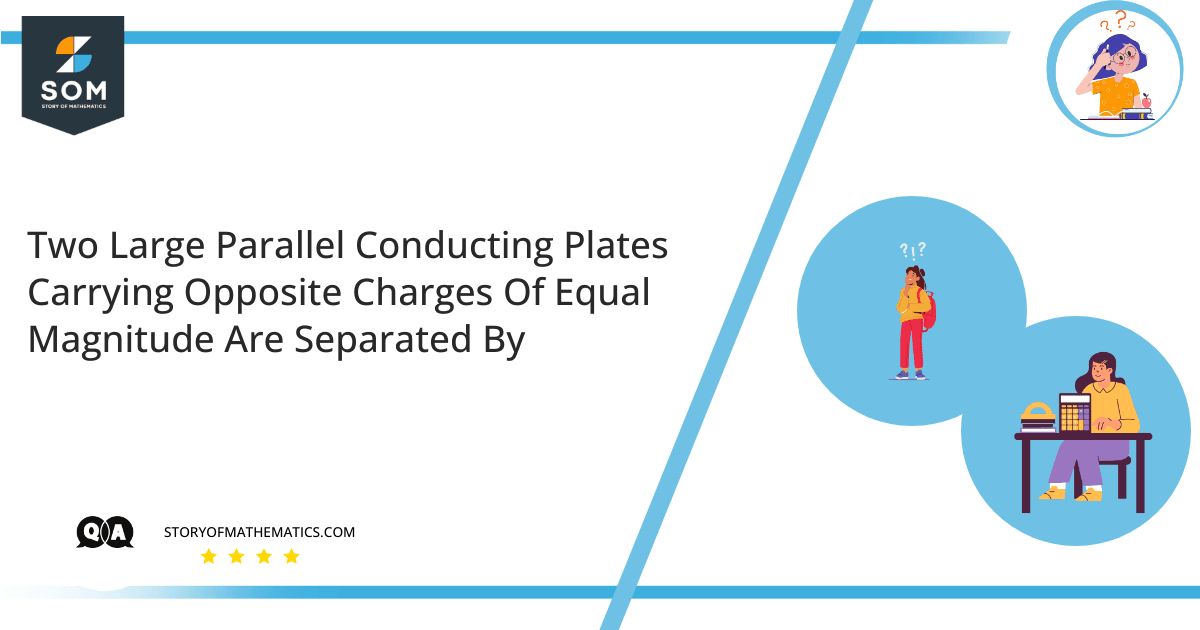
- Calculate the absolute magnitude of Electric Field E in the area between the two conducting plates if the magnitude of charge density at the surface of each place is 47.0 nC/m^2.
- Calculate the Potential Difference V that exists between the two conducting plates.
- Calculate the impact on the magnitude of Electric Field E and Potential Difference V if the distance between the conducting plates is doubled while keeping the density of charge constant at the conducting surfaces.
The aim of this article is to find the Electric Field $\vec{E}$ and Potential Difference $V$ between the two conducting plates and the impact of change in the distance between them.
The main concept behind this article is Electric Field $\vec{E}$ and Potential Difference $V$.
Electric Field $\vec{E}$ acting on a plate is defined as the electrostatic force in terms of unit charge that act on a unit area of the plate. It is represented by Gauss Law as follows:
\[\vec{E}=\frac{\sigma}{2\in_o}\]
Where:
$\vec{E}=$ Electric Field
$\sigma=$ Surface Charge Density of the Surface
$\in_o=$ Vacuum Permittivity $= 8.854\times{10}^{-12}\dfrac{F}{m}$
Potential Difference $V$ between two plates is defined as the electrostatic potential energy in terms of unit charge that acts between those two plates separated by a certain distance. It is represented as follows:
\[V=\vec{E}.d\]
Where:
$V=$ Potential Difference
$\vec{E}=$ Electric Field
$d=$ Distance between two plates
Expert Answer
Given that:
Distance between two plates $d=2.2cm=2.2\times{10}^{-2}m$
Surface Charge Density of each plate $\sigma=47.0\dfrac{n.C}{m^2}=47\times{10}^{-9}\dfrac{C}{m^2}$
Vacuum Permittivity $\in_o=8.854\times{10}^{-12}\dfrac{F}{m}$
Part (a)
Magnitude of Electric Field $\vec{E}$ acting between given two parallel plates $1$, $2$ is:
\[\vec{E}={\vec{E}}_1+{\vec{E}}_2\]
\[\vec{E}=\frac{\sigma}{2\in_o}+\frac{\sigma}{2\in_o}\]
\[\vec{E}=\frac{2\sigma}{2\in_o}=\frac{\sigma}{\in_o}\]
Substituting the value of Surface Charge Density $\sigma$ and Vacuum Permittivity $\in_o$:
\[\vec{E}=\frac{47\times{10}^{-9}\dfrac{C}{m^2}}{8.854\times{10}^{-12}\dfrac{F}{m}}\]
\[\vec{E}=5.30834\times{10}^3\frac{N}{C}\]
\[Electric\ Field\ \vec{E}=5308.34\frac{N}{C}=5308.34\frac{V}{m}\]
Part (b)
Potential Difference $V$ between given two parallel plates $1$, $2$ is:
\[V=\vec{E}.d\]
Substituting the value of Electric Field $\vec{E}$ and the distance $d$ between two plates, we get:
\[V=5.30834\times{10}^3\frac{V}{m}\times2.2\times{10}^{-2}m\]
\[Potential\ Difference\ V=116.78\ V\]
Part (c)
Given that:
The distance between the two parallel plates is double.
As per the expression of Electric Field $\vec{E}$, it is not dependent on distance, hence any change in distance between the parallel plates will not have any impact on Electric Field $\vec{E}$.
\[\vec{E}=5308.34\frac{V}{m}\]
We know that the Potential Difference $V$ between given two parallel plates $1$, $2$ is:
\[V=\vec{E}.d\]
If the distance is doubled, then:
\[V^\prime=\vec{E}.2d=2(\vec{E}.d)=2V\]
\[V^\prime=2(116.78\ V)=233.6V\]
Numerical Result
Part (a) – Magnitude of Total Electric Field $\vec{E}$ acting between given two parallel plates $1$, $2$ will be:
\[Electric\ Field\ \vec{E}=5308.34\frac{N}{C}=5308.34\frac{V}{m}\]
Part (b) – Potential Difference $V$ between given two parallel plates $1$, $2$ is:
\[V=116.78\ V\]
Part (c) – If the distance between the conducting plates is doubled, Electric Field $\vec{E}$ will not change whereas the Potential Difference $V$ will be doubled.
Example
Calculate the magnitude of Electric Field $\vec{E}$ in the area between the two conducting plates if the surface charge density of each place is $50\dfrac{\mu C}{m^2}$.
Solution
Magnitude of Total Electric Field $\vec{E}$ acting between given two parallel plates $1$, $2$ will be:
\[\vec{E}={\vec{E}}_1+{\vec{E}}_2\]
\[\vec{E}=\frac{\sigma}{2\in_o}+\frac{\sigma}{2\in_o}=\frac{\sigma}{\in_o}\]
Substituting the values, we get:
\[\vec{E}=\frac{50\times{10}^{-6}\dfrac{C}{m^2}}{8.85\times{10}^{-12}\dfrac{F}{m}}\]
\[\vec{E}=5.647\times{10}^6\frac{N}{C}=5.647\times{10}^6\frac{V}{m}\]
